15 Best Product Feedback Tools and Software
TL;DR
- Product feedback tools help collect and analyze customer insights for better UX, features, and product strategy
- 15 top tools covered, including Refiner, Qualaroo, Usersnap, Canny, Hotjar, Survicate, and UserTesting
- Mix of in-app microsurveys, feedback portals, feature voting boards, UX testing, heatmaps, and analytics
- Choose tools based on use case—surveys, voting boards, bug reporting, session tracking, or usability testing
Are you looking to collect user insights to help improve your product? Wondering what product feedback tools to use?
It’s true – You have so many different ways to improve the product.
You could follow the gut feeling, for one. There is nothing wrong with figuring out how to make your product better all by yourself.
But in reality, if you really want to take your product to the next level, then you need to get customers involved. And in practical terms, this means that you need to collect their feedback and learn more about their impressions of the product.
Now, I’m going to leave the theory behind product feedback for another time because, in this guide, I want to show you something else – I want to discuss what are the best tools that could help you improve your product.
We’ll cover:
- The concept of product feedback tools and why these tools are so important.
- We’re going to discuss the benefits of using product feedback tools you should expect.
- We’ll also go through the different types of such tools and what they help you achieve.
- And naturally, we’ll also discuss the best product feedback tools that you should try.
Let’s get right into it.
What is product feedback and product feedback software
- Product feedback is all about collecting insights, opinions, and suggestions from users or customers, with the goal of finding out how to improve a product’s features, usability, functionality, or overall user experience.
- Product feedback tools, in turn, are software platforms or systems designed to help you collect, organize, and analyze customer feedback and find out what they like about your product and what features, capabilities, or even user interface elements make it confusing or hard to use.
- Important to remember – product feedback software is a broad category of tools. It includes platforms, apps, and tools with different capabilities and feature sets. Each of them, however, have one thing in common. They all aim to help companies like yours collect data from users to help guide product development, evaluate prototypes, understand the best ways to improve the product and user experience, discover new ways to onboard new users, learn about any bugs or issues, and more.
- The most common way to collect product feedback is through different types of product feedback surveys.
- There is also a whole range of questions to ask in a product feedback survey, and the quality of the insights will largely depend on what you ask users about.
Here’s one example of a product feedback tool in action. In this case, the software collects feedback to profile and understand the customer base better.

Who needs product feedback tools?
At first sight, the answer is obvious, right? Companies making products!
But there is more to it, actually. Not all teams within a company would need the data a product feedback tool delivers. But these three particular groups do
Product teams. To them, such tools deliver invaluable feedback to drive product development, and improvements and even envision the product roadmap into the future.
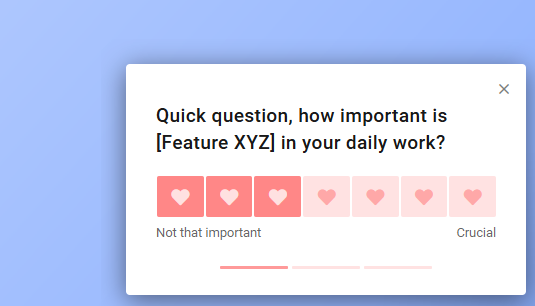
UX teams. User experience is rapidly becoming a major market differentiator. User research conducted through product feedback tools delivers the exact information to help UX teams plan and improve their customers’ experience.
Marketers. Finally, any teams involved in spreading the news about the product would regularly use customer feedback to drive their campaigns and come up with new ideas to align their messaging with customers’ needs.

What about users? Who should be providing feedback to drive your product forward?
Should you reach out to every customer you have?
Well, yes, naturally. However, you shouldn’t be showing all surveys or other research questions to them all at the same time. In fact, you should regularly segment users for the purpose of user research and collect feedback only from the most relevant people:
- Current customers when you’re looking to uncover general attitudes towards your product.
- Newly joined customers. These people can help you uncover gaps in your onboarding process and also help you understand whether your marketing message attracts the right audience.
- Churned customers to understand why your product failed to meet their expectations.
- Churned trial users to uncover why your product failed to communicate its value during the trial stage, and so on.
What are the different types of product feedback tools to use?
So far, I’ve used this label – product feedback tools – to describe all such software and platforms. But in truth, the term describes several different product categories, and I guess it’d be good to cover them pretty quickly before discussing specific tools.
So, when we talk about product feedback software, we mean:
- Customer feedback tools
- In-product survey tools
- Voice of the customer platforms
- NPS software
- Review platforms
- Feature request voting boards
- Social media monitoring tools
Now, it’s true that some of these tools share certain functionality. There are at least three or four survey categories on the list. But truth be told, they all focus on using surveys differently.
The same goes for monitoring tools, which allow you to keep track of what customers say about your product on different channels – social media, review sites, etc.
But overall, all these tools serve the same purpose – They let you gather product feedback and uncover what customers think or say about your product.
15 best product feedback tools
A quick note before we begin: Below, I’ve listed my personal product feedback software favorites. This doesn’t suggest that there are no other such tools or platforms out there. However, I believe that these tools deliver the best combination of features and capabilities for each of the use cases we described above.
It’s a long list, so if you don’t have time to read through my overview of each tool, here’s a quick run-through.
| Tool | Best used for… | Free trial available? |
| Refiner | Customer satisfaction surveys, NPS surveys, in-app feedback surveys | Yes, and also a fully-functional live demo. |
| Qualaroo | Pop-up surveys, website feedback | Yes, and a demo walkthrough option as well |
| Usertesting | Live customer interviews, usability testing | Trial available by request only |
| Uservoice | Collecting user feedback to share, analyze, and act on it across teams | Yes |
| Usersnap | In-app micro surveys and email surveys, feature boards and polls, and more | Yes |
| Delighted | NPS surveys, CSAT surveys, CES surveys | Yes |
| Feedier | Centralizing distributed customer feedback | Demo by request only |
| Canny.io | Product feature voting | Demo by request only |
| Upvoty | New feature requests, product roadmap updates | Yes |
| Getfider | Feature suggestions and voting | Yes |
| Feature Upvote | Collecting ideas and suggestions from users | Yes |
| AskNicely | Collecting customer feedback in real-time | Demo only |
| Userzoom | Running various user research methods, live video interviews, and more | Demo only |
| Hotjar | Website heatmaps, session recordings, customer feedback | Yes |
| Survicate | General surveys | Yes |
And here is complete information for each tool:
#1. Refiner

Type: Customer feedback survey tool
Best for: Customer satisfaction surveys, NPS surveys, in-app feedback surveys.
Refiner overview:
Refiner (disclaimer: this is my tool) is a complete customer feedback survey tool for SaaS & digital products. Refiner helps customers collect feedback & insights from their user base. It particularly focuses on tracking customer satisfaction metrics (NPS, CSAT, CES, etc.), as well as conducting user & product research.
Refiner’s flagship product, however, is what we call “in-product micro surveys”. These are short questionnaires that you can launch inside a web- or mobile application (iOS & Android) and capture contextual insights from a specific group of users as they are using an application.
As well as that, you can also use Refiner to send email surveys or distribute them with shareable survey links. These surveys can be used to capture feedback from users that are not currently using an application (abandoned purchases, canceled subscriptions, etc.)
Learn more about using Refiner to collect customer and product feedback.
#2. Qualaroo

Type: User research and customer feedback software
Best for: pop-up surveys, website feedback
Qualaroo overview:
Qualaroo helps collect customer feedback as users interact with your product or visit the website. With Qualaroo’s popup surveys, you can find out what customers think of your product or its different sections, learn whether your product delivers on your user base’s needs, and so on.
But unlike tools like Refiner, however, Qualaroo focuses only on feedback from users who are engaging with your product. As a result, it does not offer you the option to email surveys to users or evaluate the sentiment of people who have abandoned your app, for example.
#3. Usertesting
Type: User testing tool
Best for: Live customer interviews, usability testing
Usertesting overview:
Usertesting is all about using video to watch how users interact with your product or a prototype and experience what they experience in the process.
With Usertesting, you can run a whole range of customer research, including live interviews, usability testing, card sorting or tree testing, and more.
If you’re also at the prototyping stage, you can use Usertesting to build a research panel, pay and manage incentives, and collect feedback before you even create the product.
#4. Uservoice

Type: Product feedback tool
Best for: Collecting user feedback to share, analyze, and act on it across teams.
Uservoice overview:
Uservoice greets its website visitors with this slogan – Behind every great product is great customer feedback. They couldn’t be more right, of course. But what’s more, the platform’s feature set fully compliments that statement.
Uservoice lets you collect user feedback with in-app widgets, analyze the data (and share with everyone involved) to drive product development, identify top areas of improvement, and prioritize the product roadmap.
#5. Usersnap
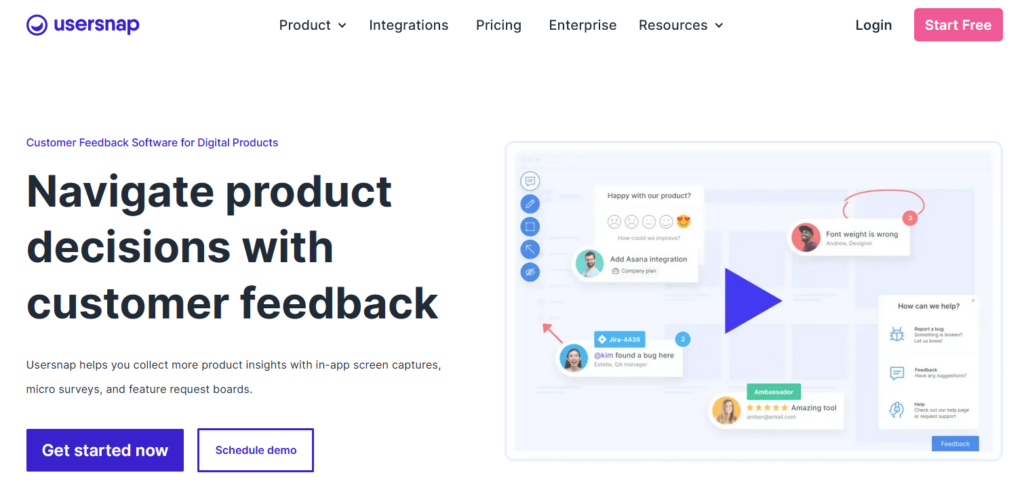
Type: Voice of the customer tool
Best for: In-app micro surveys and email surveys, feature boards and polls, and more.
Usersnap overview:
Usersnap is a voice-of-the-customer tool that, very much like Refiner, also lets you collect customer feedback through micro surveys.
But to be more specific – With Usersnap, you can display surveys in-app to collect feedback from users as they interact with your product. Or you can send your questions to them via email, and let them process their replies at the time of their choosing.
Aside from being a voice of the customer tool, Usersnap offers several additional features that help companies make better product decisions: feature request boards, new feature polls, screen captures, and more.
#6. Delighted
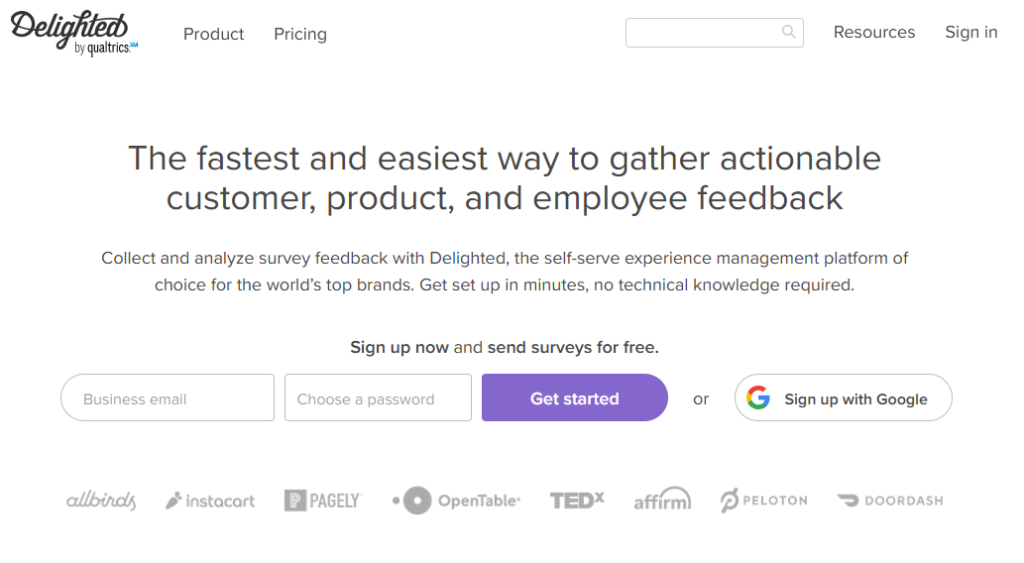
Type: Customer feedback survey tool
Best for: NPS surveys, CSAT surveys, CES surveys
Delighted overview:
Delighted is a survey platform that lets you set up questionnaires to collect different types of customer satisfaction feedback. With Delighted, you can quickly set up and run NPS and CSAT surveys but also evaluate product-market fit and even research your employee satisfaction.
You can then distribute surveys through email, display them on a website through a dedicated widget, or use a shareable link to post questionnaires on social media, for example.
#7. Feedier

Type: Feedback collection and analysis platform
Best for: Centralizing distributed customer feedback
Feedier overview:
Feedier focuses not as much on collecting feedback (although the platform offers functionality to run interactive surveys, for example) but on bringing all decentralized feedback into one place and analyzing it to draw actionable insights.
Feedier allows you to upload already existing feedback, organize it with context, monitor for new feedback in real-time, and more.
#8. Canny

Type: Product feature board
Best for: Product feature voting, feedback analysis
Canny overview:
Canny is a product voting and feedback analysis tool that lets you understand what your customers want and build products that match their needs. Canny lets you collect votes on product features privately or through a public board. You can also use existing customer data to enrich their feedback and use these enriched profiles to analyze the data and draw actionable conclusions.
All this will help you prioritize the roadmap and ensure that you continuously ship what your customers really need.
#9. Upvoty

Type: User feedback collection tool
Best for: New feature requests, product roadmap updates
Upvoty overview:
Upvoty is a tool you use when you need to figure out what to build next. The platform features a nifty new feature request board that lets customers submit new ideas and feature suggestions. You can also use Upvoty to display your product roadmap, and make your changelog public.
What’s more, you can launch the product board and roadmap on your custom domain or embed them seamlessly into your product.
#10. Fider

Type: User feedback collection and feature suggestions tool
Best for: Feature suggestions, customer feedback
Fider overview:
Fider is simple (yet very powerful!) platform that lets you set up a customer feedback portal where users can suggest improvements or share ideas they have for future product enhancements. Users can also vote on suggestions, meaning that you can quickly discover what the majority of your customers need and prioritize the roadmap accordingly.
#11. Feature Upvote
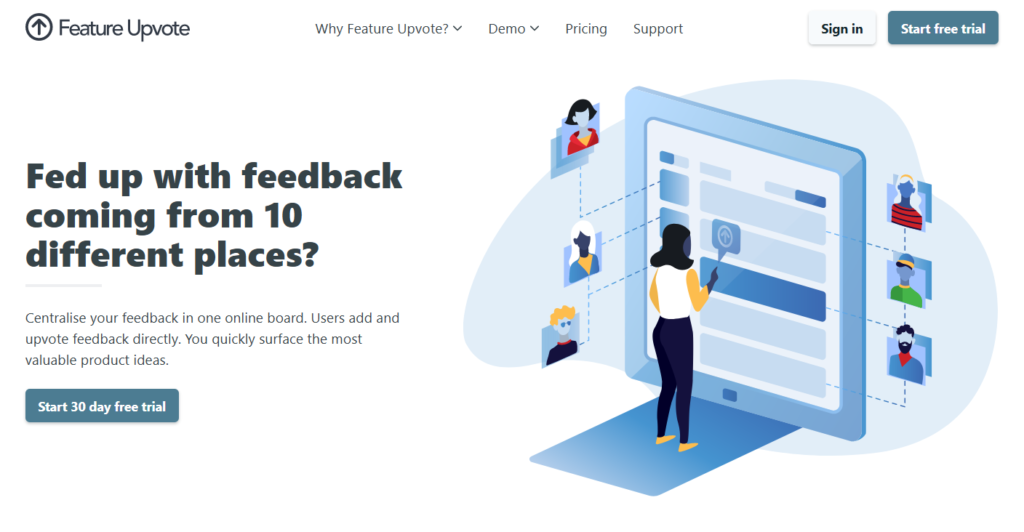
Type: Feature upvoting tool
Best for: Collecting ideas and suggestions from users.
Feature Upvote overview:
Feature Upvote is a lightweight tool designed to make collecting ideas and suggestions from users as easy as possible. For that reason, Feature Upvote voting boards are public, to reduce the friction of having to first create an account and log in to leave feedback. But to make the feedback you receive as valuable and honest, Feature Upvote features capabilities that detect when users try to vote multiple times, and so on.
But what’s the most important thing about Feature Upvote is its simplicity. You can set up a voting board in literally a minute, and have users leave comments and suggestions almost instantly.
#12. AskNicely
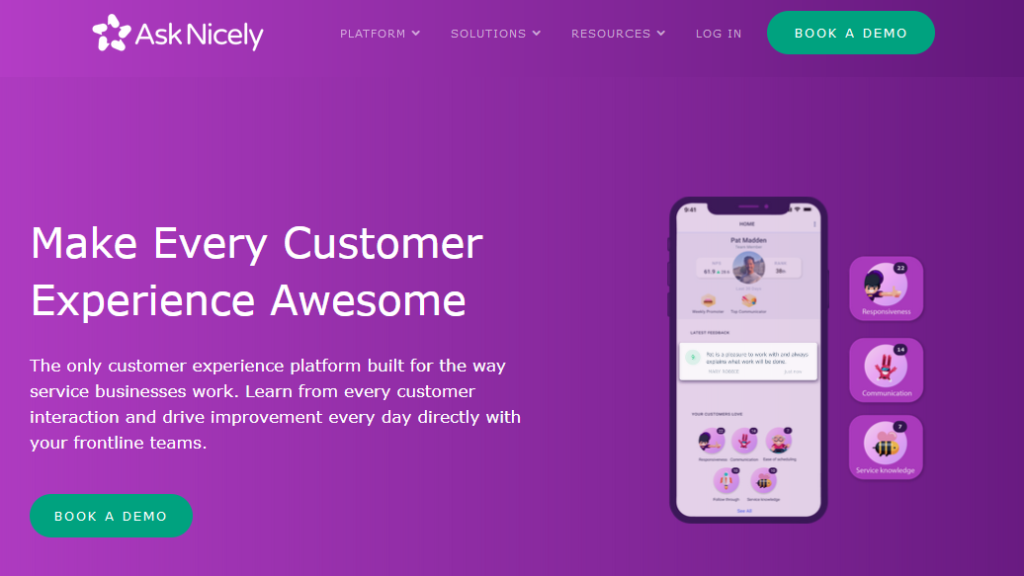
Type: Voice of the customer tool
Best for: Collecting customer feedback in real-time
AksNicely overview:
AskNicely primarily helps service businesses. That said, there are certain ways you can use it to collect the voice of the customer in real-time for a digital product. Overall, AskNicely uses mobile apps to let you collect feedback right after the service delivery. But you can do the same right after customer support interaction, for example, or any other meeting that involves you discussing the product with customers.
With the mobile app, you can collect NPS surveys, for example, and know the customer satisfaction level right after you’ve finished interacting with them.
#13. Userzoom

Type: All-in-one UX research tool
Best for: Running various user research methods, live video interviews, and more.
Userzoom overview:
Userzoom is a robust UX research platform allowing you to run a whole range of research projects and use methods ranging from surveys to live interviews.
On top of that, Userzoom lets you recruit participants for your research and use various automations to speed up data analysis.
#14. Hotjar

Type: Website behavior analytics tool
Best for: Website heatmaps, session recordings, customer feedback
Hotjar overview:
Although Hotjar offers a way to run simple surveys to collect customer insights, its primary focus is on delivering behavioral data to uncover customer preferences. To do that, Hotjar lets you analyze the user’s behavior on the page with heatmaps, user session recordings, and more. Finally, you can also use Hotjar to run moderated user interviews and dig deeper into their attitudes toward your product.
#15. Survicate
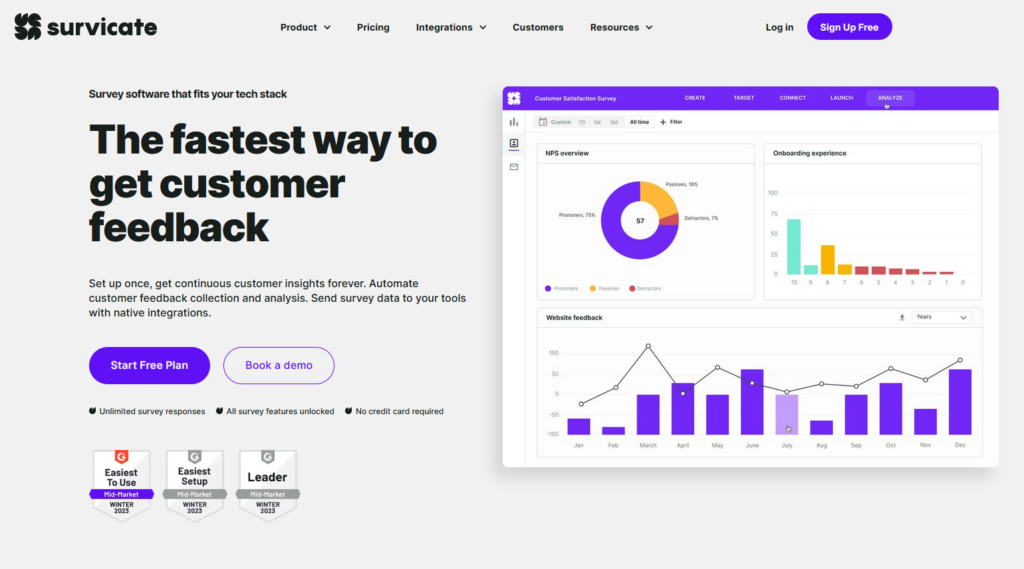
Type: Customer survey tool
Best for: General surveys
Survicate overview:
Survicate is a customer survey tool focusing on helping small to medium businesses run surveys to uncover their customers’ preferences and needs.
Companies can use the company’s tool to gather feedback from customers and collect actionable insights to help drive their business and products forward.
Survicate supports several survey types like NPS and lets you distribute them through email, run website surveys, in-app surveys, and also embed surveys directly into Intercom Messenger.
And that’s it…
Now you know 15 of the best product feedback tools to help you uncover what customers think of your product and what ideas they might have for you to take it to the next level.
Product feedback tools – FAQ
That’s Refiner, designed to collect NPS, CSAT or CES while users are in your app, with targeting and analytics built-in.
Try Canny, Fider, Upvoty or Feature Upvote—they let users submit and vote on ideas directly in your product.
Use Hotjar for heatmaps and session recordings, and Usersnap to capture feedback with screenshots.
Pick UserTesting or Userzoom for detailed interviews, role-play testing, and UX studies.
Often yes, you’ll combine surveys, voting boards, and analytics depending on your needs. Overlap exists, but use cases differ.









